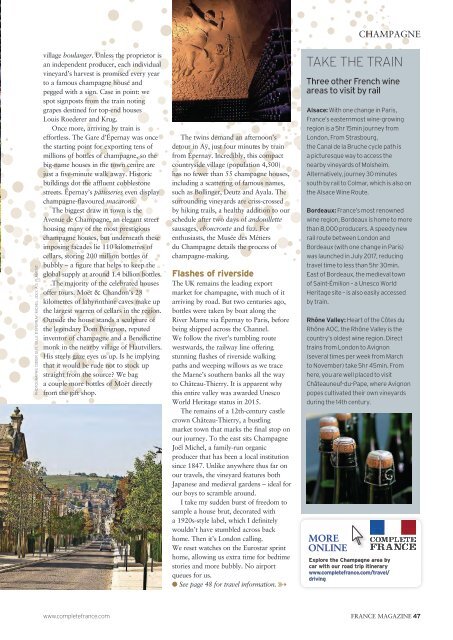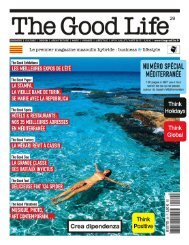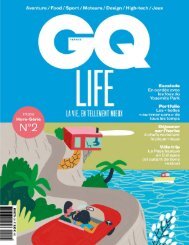You also want an ePaper? Increase the reach of your titles
YUMPU automatically turns print PDFs into web optimized ePapers that Google loves.
PHOTOGRAPHS: DIDIER GUY; VILLE D’ÉPERNAY; MICHEL JOLY; A.S. FLAMENT<br />
village boulanger. Unless the proprietor is<br />
an independent producer, each individual<br />
vineyard’s harvest is promised every year<br />
to a famous champagne house and<br />
pegged with a sign. Case in point: we<br />
spot signposts from the train noting<br />
grapes destined for top-end houses<br />
Louis Roederer and Krug.<br />
Once more, arriving by train is<br />
effortless. The Gare d’Épernay was once<br />
the starting point for exporting tens of<br />
millions of bottles of champagne, so the<br />
big-name houses in the town centre are<br />
just a five-minute walk away. Historic<br />
buildings dot the affluent cobblestone<br />
streets. Épernay’s pâtisseries even display<br />
champagne-flavoured macarons.<br />
The biggest draw in town is the<br />
Avenue de Champagne, an elegant street<br />
housing many of the most prestigious<br />
champagne houses, but underneath these<br />
imposing facades lie 110 kilometres of<br />
cellars, storing 200 million bottles of<br />
bubbly – a figure that helps to keep the<br />
global supply at around 1.4 billion bottles.<br />
The majority of the celebrated houses<br />
offer tours. Moët & Chandon’s 28<br />
kilometres of labyrinthine caves make up<br />
the largest warren of cellars in the region.<br />
Outside the house stands a sculpture of<br />
the legendary Dom Pérignon, reputed<br />
inventor of champagne and a Benedictine<br />
monk in the nearby village of Hautvillers.<br />
His steely gaze eyes us up. Is he implying<br />
that it would be rude not to stock up<br />
straight from the source? We bag<br />
a couple more bottles of Moët directly<br />
from the gift shop.<br />
The twins demand an afternoon’s<br />
detour in Aÿ, just four minutes by train<br />
from Épernay. Incredibly, this compact<br />
countryside village (population 4,500)<br />
has no fewer than 55 champagne houses,<br />
including a scattering of famous names,<br />
such as Bollinger, Deutz and Ayala. The<br />
surrounding vineyards are criss-crossed<br />
by hiking trails, a healthy addition to our<br />
schedule after two days of andouillette<br />
sausages, choucroute and fizz. For<br />
enthusiasts, the Musée des Métiers<br />
du Champagne details the process of<br />
champagne-making.<br />
Flashes of riverside<br />
The UK remains the leading export<br />
market for champagne, with much of it<br />
arriving by road. But two centuries ago,<br />
bottles were taken by boat along the<br />
River Marne via Épernay to Paris, before<br />
being shipped across the Channel.<br />
We follow the river’s tumbling route<br />
westwards, the railway line offering<br />
stunning flashes of riverside walking<br />
paths and weeping willows as we trace<br />
the Marne’s southern banks all the way<br />
to Château-Thierry. It is apparent why<br />
this entire valley was awarded Unesco<br />
World Heritage status in 2015.<br />
The remains of a 12th-century castle<br />
crown Château-Thierry, a bustling<br />
market town that marks the final stop on<br />
our journey. To the east sits Champagne<br />
Joël Michel, a family-run organic<br />
producer that has been a local institution<br />
since 1847. Unlike anywhere thus far on<br />
our travels, the vineyard features both<br />
Japanese and medieval gardens – ideal for<br />
our boys to scramble around.<br />
I take my sudden burst of freedom to<br />
sample a house brut, decorated with<br />
a 1920s-style label, which I definitely<br />
wouldn’t have stumbled across back<br />
home. Then it’s London calling.<br />
We reset watches on the Eurostar sprint<br />
home, allowing us extra time for bedtime<br />
stories and more bubbly. No airport<br />
queues for us.<br />
● See page 48 for travel information. ➳<br />
MORE<br />
ONLINE<br />
CHAMPAGNE<br />
TAKE THE TRAIN<br />
Three other French wine<br />
areas to visit by rail<br />
Alsace: With one change in Paris,<br />
<strong>France</strong>’s easternmost wine-growing<br />
region is a 5hr 15min journey from<br />
London. From Strasbourg,<br />
the Canal de la Bruche cycle path is<br />
a picturesque way to access the<br />
nearby vineyards of Molsheim.<br />
Alternatively, journey 30 minutes<br />
south by rail to Colmar, which is also on<br />
the Alsace Wine Route.<br />
Bordeaux: <strong>France</strong>’s most renowned<br />
wine region, Bordeaux is home to more<br />
than 8,000 producers. A speedy new<br />
rail route between London and<br />
Bordeaux (with one change in Paris)<br />
was launched in July <strong>2017</strong>, reducing<br />
travel time to less than 5hr 30min.<br />
East of Bordeaux, the medieval town<br />
of Saint-Émilion – a Unesco World<br />
Heritage site – is also easily accessed<br />
by train.<br />
Rhône Valley: Heart of the Côtes du<br />
Rhône AOC, the Rhône Valley is the<br />
country’s oldest wine region. Direct<br />
trains from London to Avignon<br />
(several times per week from March<br />
to November) take 5hr 45min. From<br />
here, you are well placed to visit<br />
Châteauneuf-du-Pape, where Avignon<br />
popes cultivated their own vineyards<br />
during the 14th century.<br />
Explore the Champagne area by<br />
car with our road trip itinerary<br />
www.completefrance.com/travel/<br />
driving<br />
www.completefrance.com FRANCE MAGAZINE 47






